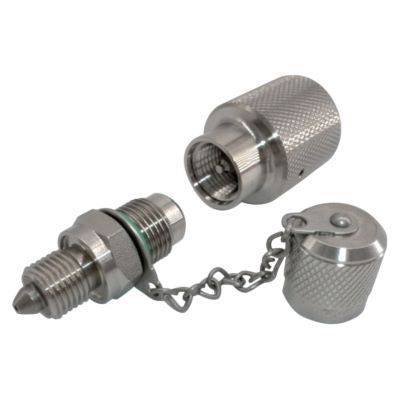Hydraulic systems are the lifeblood of countless machines across various industries. Hydraulics power and control construction equipment, agricultural machinery, and factory automation efficiently.
Hydraulics need regular maintenance for best performance and to avoid downtime. This is where hydraulic test port fittings come into play.
What are Hydraulic Test Port Fittings?
Hydraulic test port fittings are specialized components. They provide access points in a hydraulic system. They typically consist of a coupler body, a valve, and a seal. Technicians can monitor system health and diagnose problems by connecting to these test ports. This can be done without interrupting operation.
Different types of test port fittings exist, including ball and sleeve designs and poppet type fittings. They are made from materials such as steel and stainless steel. This helps them endure tough hydraulic system conditions.
Types of Hydraulic Test Port Fittings
Here are the different types of test port fittings used in different application:
➡️ Ball and Sleeve Design:
This is a popular choice due to its simple and reliable operation. It features a ball bearing that seals the port opening when not in use. When a test coupler is connected, the ball retracts into the sleeve, allowing pressure readings or fluid sampling.
➡️ Poppet Type Fitting:
This design utilizes a spring-loaded poppet valve that remains closed until a compatible coupler is engaged. The coupler depresses the poppet valve, opening the port for connection. Poppet type fittings offer a secure connection and are ideal for high-pressure applications.
➡️ Shut-Off Coupler Design:
These include a shutoff valve integrated into the coupler itself. This allows for connection and disconnection under pressure. It minimizes fluid loss and potential contamination during testing.
➡️ Gauge Port Fittings:
Designed specifically for attaching pressure gauges, these fittings often come with a dust cap to keep the port clean when not in use. They may also have a restricted orifice to protect the gauge from pressure spikes.
Benefits of Using Hydraulic Test Port Fittings
The benefits of incorporating hydraulic test port fittings into your system are numerous. Here are some key advantages:
➡️ Preventative Maintenance:
Technicians can monitor pressure readings at key points using test ports. This eliminates the need to shut down the entire system. Early detection finds leaks, worn parts, and fluid issues before they become major problems.
➡️ Improved Diagnostics:
Test ports allow easy connection of pressure gauges, diagnostic tools, and fluid sampling equipment. This speeds up troubleshooting and finding the root problem, making repairs more efficient.
➡️ Increased System Uptime:
By enabling preventative maintenance and early problem detection, hydraulic test port fittings help prevent costly downtime and repairs. They contribute to a predictable maintenance schedule. This minimizes disruptions to your operations.
➡️ Safety Enhancement:
Test ports offer a safe method to release pressure for system maintenance. They also provide a controlled way for troubleshooting. They allow fluid sampling to monitor contamination, which prevents accidents.
Applications of Hydraulic Test Port Fittings
Hydraulic systems are prevalent in a wide range of industries. Some of the most common applications for hydraulic test port fittings include:
➡️ Construction equipment (excavators, loaders, cranes)
➡️ Agricultural machinery (tractors, harvesters, planters)
➡️ Manufacturing equipment (industrial presses, injection molding machines, robotics)
➡️ Mining equipment (drones, excavators, haul trucks)
➡️ Wind turbines
Curious to know how to build seamless connections? Check these out⬇️⬇️⬇️
Building Connections: The Role Of Blank Flanges
Reducer Pipe Fittings Unwrapped: The Key To Seamless Flow!
Choosing the Right Hydraulic Test Port Fittings
When selecting hydraulic test port fittings, several factors need to be considered:
➡️ Pressure Rating: Ensure the chosen fittings can handle the maximum operating pressure of your hydraulic system.
➡️ Thread Size: Choose fittings with threads that match the existing ports on your equipment.
➡️ Compatibility: Opt for fittings that are compatible with the type of hydraulic fluid used in your system.
➡️ Material: Select fittings constructed from durable materials like steel or stainless steel to withstand harsh environments.
Remember, use high-quality hydraulic test port fittings for optimal performance and system safety.
Conclusion
Hydraulic test port fittings maximize hydraulic system efficiency, uptime, and safety. By enabling preventative maintenance, improved diagnostics, and a proactive approach to system health, test ports can significantly reduce downtime and repair costs. Invest in a thorough hydraulic test port fitting strategy. This will optimize your system’s performance and longevity.
Contact our experts for information on hydraulic test port fittings. Get help with installation and integration into your maintenance plan. We’re happy to answer any questions and help you choose the right solutions for your specific needs.
Post time: Apr-02-2024


